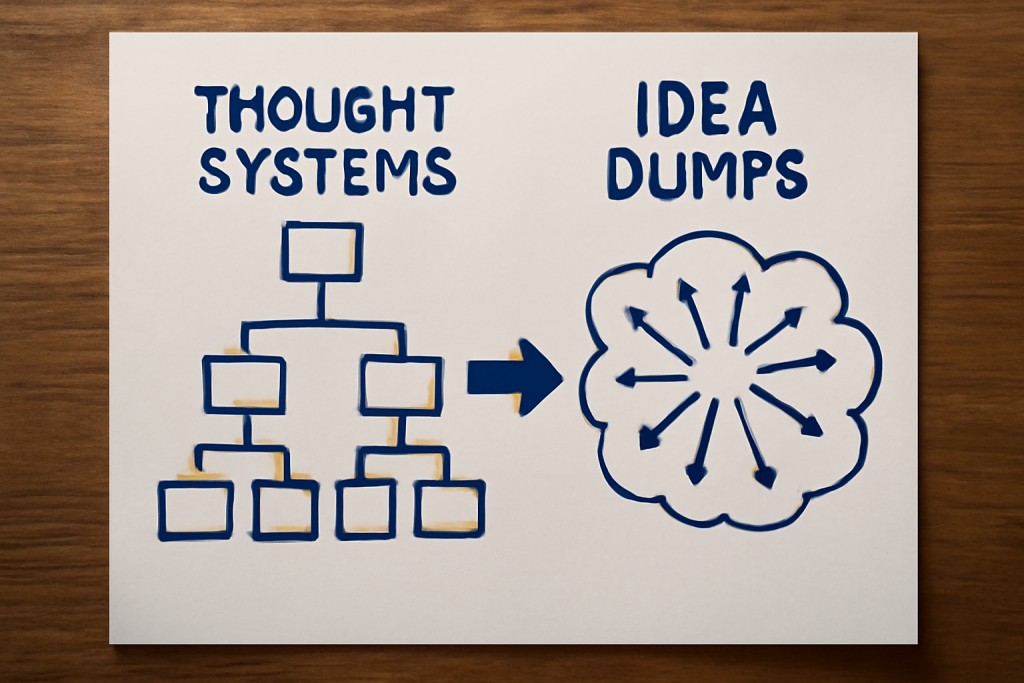Thought Systems Beat Idea Dumps
Brian Taylor July 28, 2025
In an age where creativity and innovation are more important than ever, the way we approach problem-solving and idea generation matters. For years, the conventional approach has been to throw as many ideas at the wall as possible—an “idea dump,” if you will. While this method might sound familiar, especially in brainstorming sessions, it is no longer the most effective strategy for fostering meaningful creativity. In fact, thought systems beat idea dumps when it comes to producing quality ideas, solving complex problems, and nurturing innovative thinking.
As the world continues to evolve, the need for structured, clear, and focused thinking becomes more evident, particularly within education and society. Structured thinking—organized, logical processes for problem-solving and idea generation—helps individuals and organizations stay focused, connect dots more effectively, and enhance collaboration. On the other hand, the chaotic nature of idea dumps often leads to disorganized solutions, wasted energy, and lack of direction.
In this article, we explore why thought systems are more effective than idea dumps, how structured thinking can be integrated into educational settings, and why this approach is vital for societal progress.

The Role of Thought Systems in Organizing Ideas
A thought system is a framework or methodology for organizing, analyzing, and acting upon ideas. Think of it as a blueprint for creative and critical thinking. In essence, a thought system helps guide the thought process, allowing individuals to stay focused, ensure clarity, and find connections between ideas. It involves structure, clarity, and a strategic approach to problem-solving and idea development.
Contrast this with an idea dump—a free-flowing, unorganized stream of thoughts that often lacks coherence, focus, and practical application. Idea dumps are often the result of unfiltered brainstorming, where quantity is prioritized over quality, and individuals are encouraged to throw out as many ideas as possible, regardless of feasibility or relevance.
While idea dumps can serve as a starting point, they are not as effective in creating actionable plans or solving complex problems. This is where thought systems shine: they bring order to chaos, making it easier to refine ideas, connect the dots, and take focused action.
Why Thought Systems Are More Effective Than Idea Dumps
1. Clarity and Focus in Idea Generation
A key advantage of thought systems is the clarity they provide. When ideas are structured, it becomes easier to evaluate them critically and determine their relevance. In an idea dump, the sheer volume of unorganized ideas can overwhelm individuals, leading to confusion and lack of direction.
Structured thinking helps clarify goals, align strategies, and focus on the most important factors. For instance, frameworks like mind mapping or SWOT analysis allow individuals to see relationships between different elements, making it easier to prioritize actions and identify the best solutions.
2. Enhanced Problem-Solving through Organized Ideas
Problem-solving requires a systematic approach, and thought systems provide the necessary structure for this. The nature of problem-solving involves breaking down complex issues into manageable parts, analyzing possible solutions, and testing ideas. Without a thought system, individuals may struggle to break down problems effectively, leading to fragmented solutions and missed opportunities.
Thought systems, like design thinking or critical thinking models, offer step-by-step processes that encourage logical analysis and creative solutions. This structured approach not only helps individuals come up with better solutions but also ensures that those solutions are well thought out and actionable.
3. Boosted Creativity through Structured Idea Development
It may seem counterintuitive, but structured thinking actually fosters creativity. When people work within a framework, they are more likely to see opportunities they might have missed in a more chaotic environment. By limiting distractions and narrowing focus, thought systems provide the clarity necessary for true creativity to emerge.
In fact, several creativity techniques, such as SCAMPER (Substitute, Combine, Adapt, Modify, Put to another use, Eliminate, and Reverse), are based on structured thinking. These frameworks guide the creative process by encouraging individuals to systematically explore different angles of a problem, leading to innovative ideas.
4. Increased Collaboration and Communication with Structured Ideas
Another benefit of thought systems is their ability to improve collaboration. When teams work together using a structured approach, it’s easier to communicate ideas, track progress, and align efforts. With idea dumps, the lack of structure can lead to miscommunication and confusion, making it hard for teams to find common ground.
Structured thinking ensures that every team member understands the goals, the process, and how their ideas contribute to the larger project. This shared understanding makes collaboration smoother and more effective, which is especially crucial in team-based environments.
5. Sustainable Results from Organized Ideas
One of the most significant drawbacks of idea dumps is that they often lead to short-lived results. While dumping ideas can lead to some initial inspiration, the lack of structure usually prevents those ideas from being fully developed or implemented. Thought systems, on the other hand, encourage the refining and testing of ideas, leading to sustainable and actionable outcomes that have long-lasting impact.
In both education and society, the ability to build on ideas over time is key to creating real, lasting change. Thought systems ensure that ideas evolve in a structured and purposeful way, allowing for consistent progress and improvement.
How Thought Systems Can Be Integrated into Education
In the classroom, teaching students how to organize their thoughts and ideas is essential for their intellectual development. Integrating structured thinking techniques into the learning process can help students develop stronger problem-solving and critical thinking skills, which will benefit them in academics and later in life.
1. Teaching Critical Thinking Frameworks
Teachers can introduce students to various critical thinking frameworks, such as the Paul-Elder Critical Thinking Model or Bloom’s Taxonomy, which provide structured approaches to analyzing and evaluating ideas. These models teach students to break down complex problems and think through solutions in a logical, step-by-step manner.
2. Project-Based Learning Using Structured Idea Systems
Project-based learning (PBL) is an educational approach that encourages students to work collaboratively on real-world problems. By using thought systems like design thinking or systems thinking, PBL allows students to approach challenges in a structured way, resulting in creative and actionable solutions.
3. Mind Mapping and Visual Tools for Idea Organization
Mind mapping is a powerful tool for visualizing thoughts and ideas. It helps students organize their thoughts and connect concepts, making it easier to understand complex topics and find innovative solutions. Incorporating mind maps into the learning process helps students see how their ideas fit into a larger framework, making it easier to communicate their thoughts effectively.
How Thought Systems Drive Societal Progress
In society, structured thinking is just as important. Social issues, economic challenges, and environmental crises often require complex, systematic solutions. Thought systems beat idea dumps when it comes to tackling large-scale societal problems because they allow us to analyze, prioritize, and implement solutions in a more focused and organized manner.
1. Policy Development with Structured Ideas
Governments and organizations use structured thinking methods, such as cost-benefit analysis or stakeholder analysis, to create policies that address social challenges. These tools allow decision-makers to assess the potential impact of policies, weigh various options, and ensure that decisions are well-informed.
2. Innovation in Technology and Business through Organized Ideas
The technology and business sectors thrive on innovation, and thought systems are essential for driving this forward. Frameworks like agile development, lean startup, and systems thinking help companies and innovators approach problems strategically, leading to more effective and sustainable innovations.
Conclusion: Embrace Thought Systems for Success
In both education and society, thought systems beat idea dumps in every way that matters. Whether you’re solving a complex problem, generating creative ideas, or trying to make a meaningful change, structured thinking provides the clarity, focus, and direction needed for success. By adopting and integrating thought systems into our daily lives, we can foster creativity, collaboration, and innovation that will lead to long-term success and progress.
References
Paul, R., & Elder, L. (2014). The Miniature Guide to Critical Thinking Concepts and Tools. Foundation for Critical Thinking. Available at: https://www.criticalthinking.org/store/product/the-miniature-guide-to-critical-thinking-concepts-and-tools
Dyer, J., & Gregersen, H. (2018). The Innovator’s DNA: Mastering the Five Skills of Disruptive Innovators. Harvard Business Review Press. Available at: https://hbr.org/product/the-innovators-dna-mastering-the-five-skills-of-disruptive-innovators/18456
Senge, P. (2006). The Fifth Discipline: The Art & Practice of The Learning Organization. Doubleday. Available at: https://www.penguinrandomhouse.com/books/143565/the-fifth-discipline-by-peter-m-senge/





